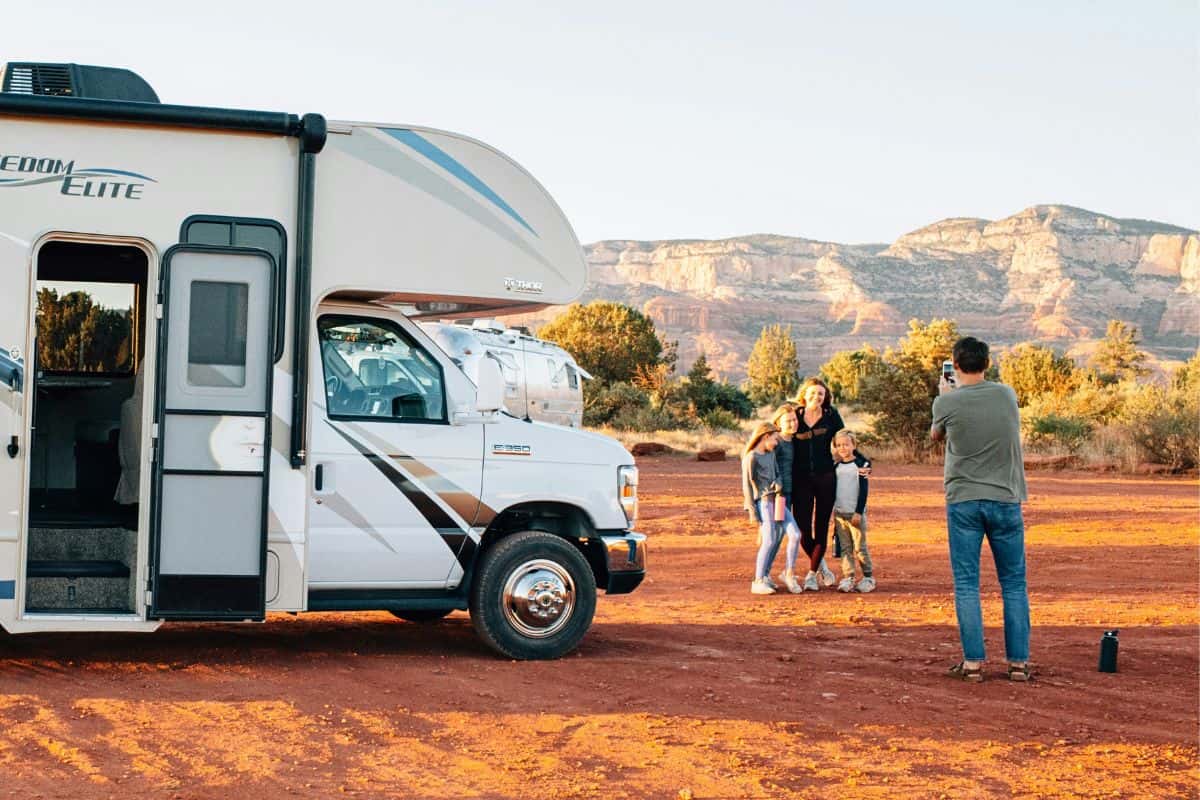Picture this: your kids laughing as they spot a moose outside their bedroom window, learning geography by visiting state capitals, and family bonding around a campfire instead of a TV.
Full-time RV living with kids isn’t just a dream – it’s becoming a reality for many American families seeking a more adventurous and meaningful lifestyle.
Living in an RV full-time with kids offers unique opportunities for learning and stronger family bonds. But let’s be real, it also comes with its own set of challenges requiring planning and practical solutions.
So to help with this, we’ll explore the 7 keys to successful full-time RV living with kids with actionable advice based on real experience. From choosing the right RV to maintaining social connections, we’ll cover everything you need to know to make this lifestyle work for the whole family.
Key 1: Have an Open Family Dialogue About Full-Time RV Living
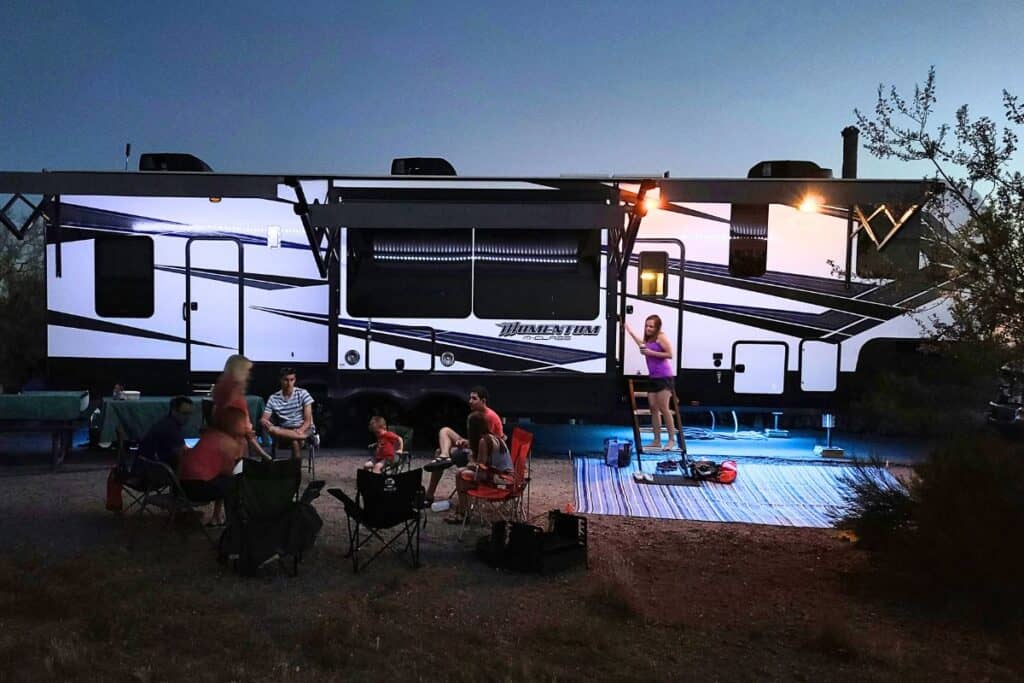
An important factor in transitioning to full-time RV living with kids is open, honest dialogue.
Starting the conversation early gives your children time to process this life-changing decision. Remember, while you’ve likely spent months researching and dreaming about RV life, this is all new to them.
Begin by sharing your vision for this family adventure, but more importantly, create space for their thoughts, concerns, and dreams.
Here are the most common concerns children typically express about full-time RV living:
- Social Worries
- Leaving best friends behind
- Missing birthday parties and playdates
- Fear of being “different” from other kids
- Concerns about making new friends
- Daily Life Changes
- Switching to homeschooling or remote learning
- Giving up regular activities and sports teams
- Having less personal space
- Sharing smaller living quarters with siblings
One of the most effective approaches in dealing with these concerns is to hold family meetings about the RV lifestyle. These shouldn’t feel like lectures – think of them more as collaborative planning sessions.
You’ll find that involving your kids in researching RV parks, planning routes, and even creating their bucket lists of places to visit will help them feel more invested and excited about the journey.
Remember, this transition isn’t just about changing your living space, it’s about transforming your entire family dynamic.
Most importantly, keep these conversations ongoing. Your children’s feelings and needs will evolve as they process the idea and eventually experience life on the road.
Key 2: Choose the Right RV for Your Family
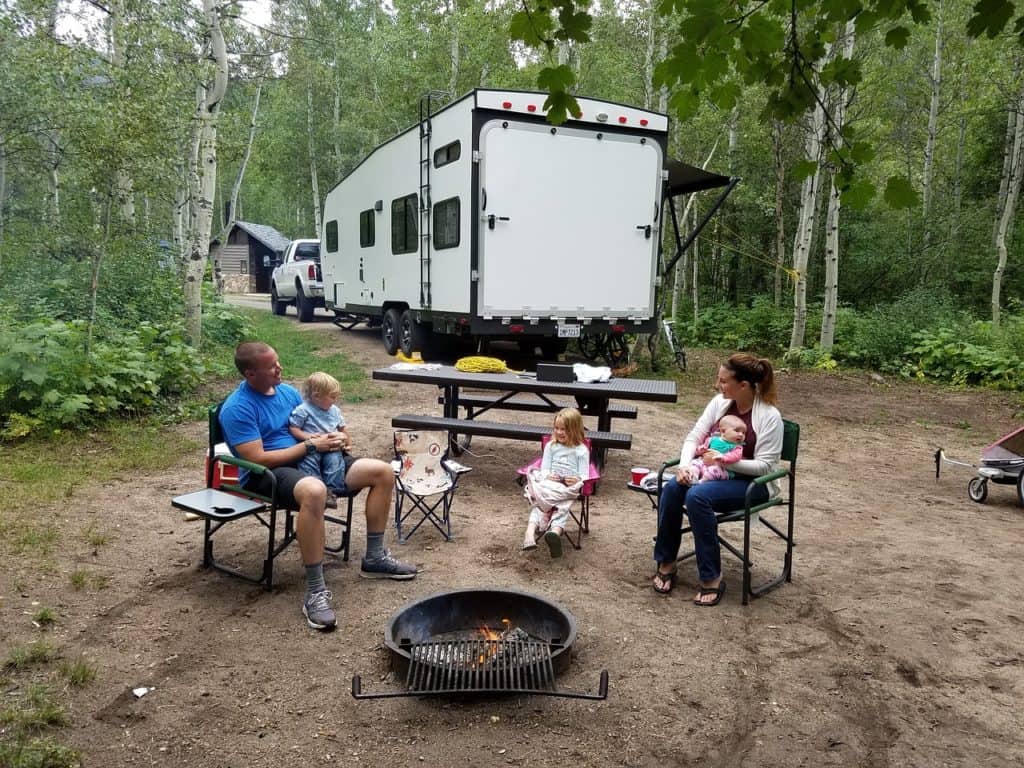
Selecting the right camper for full-time RVing with kids is another important decision, as this one choice will impact every aspect of daily RV life. From storage space to sleeping arrangements to overall comfort and enjoyment.
The first thing to decide is whether to go with a motorized or towable RV.
While motorhomes offer the convenience of having your living space and transportation combined, fifth wheels and travel trailers typically provide more living space for the money.
For many RVers living full-time, the 5th-wheel camper is often the best choice, thanks to its residential feel and superior storage capacity. However, this is a personal decision, as every family dynamic is different.
Primary RV Types Suitable for Full-time Family Living
- Motorhomes (Class A, Class C, or Super C)
- Pros: All-in-one vehicle, easier setup
- Cons: More expensive, requires tow vehicle for errands
- Fifth Wheels
- Pros: Most living space, residential feel, superior storage
- Cons: Requires heavy-duty truck, longer setup time
- Travel Trailers
- Pros: Most affordable, variety of sizes
- Cons: Less storage, typically smaller bedrooms and bathrooms
When it comes to layout, bunkhouse floor plans are hard to beat for kids, as these floorplans give kids their own space. Something great for both kids and adults.
The RV kitchen also deserves special attention. Unlike weekend camping, full-time living means you’ll be preparing most meals in your camper. Look for residential-size refrigerators, adequate counter space, large range/ovens, and sufficient cabinet storage.
Size also matters when choosing an RV for full-time family living. While it’s tempting to go as large as possible, remember that bigger RVs mean fewer camping options and more challenging driving. We’ve found that 30 to 40-foot RVs tend to be the sweet spot for most families, offering ample living space while still maintaining reasonable maneuverability.
Here are a few other points to consider when choosing a family-friendly RV:
- Must-Have Amenities
- Durable construction and materials
- Separate bedroom
- Lots of sleeping capacity
- Good size fresh/gray/black tanks
- Separate rooms or spaces inside the RV
- Lots of storage
- Nice To Have Features
- Multiple full bathrooms or bath-and-a-half
- Bunk room or bunk beds
- Multiple entry doors
- Outdoor kitchen or entertainment area
- Four-season capability
- Wash/dryer hookups
Key 3: Perfect Space Organization
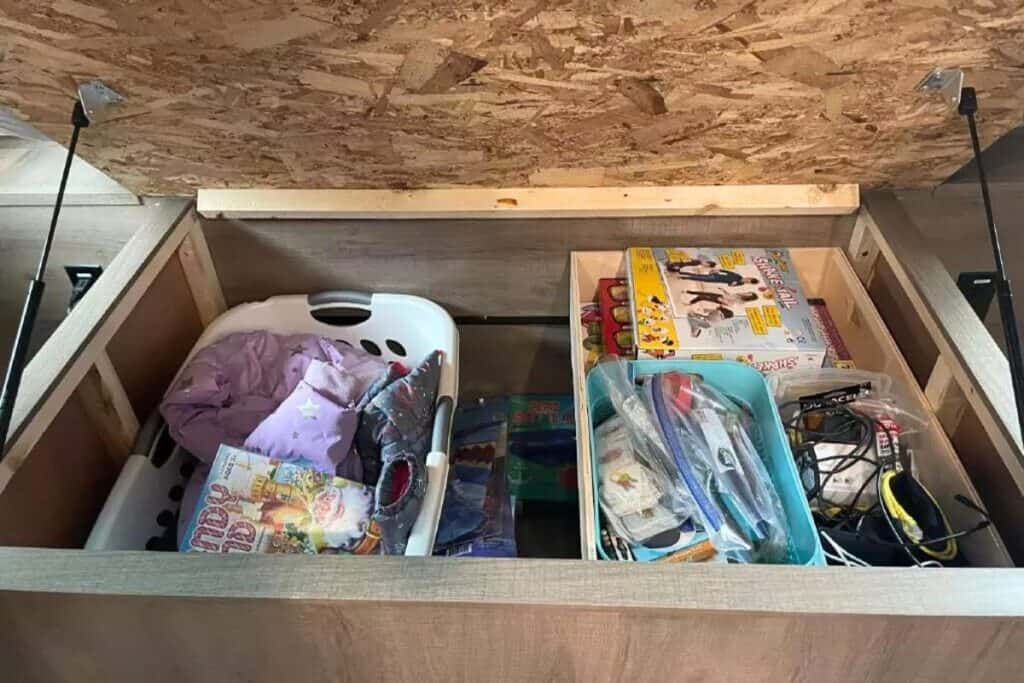
With or without kids transitioning from a traditional home to full-time RV living means downsizing from thousands of square feet to just a few hundred.
But here’s the secret, it’s not about having less stuff; it’s about being smarter with the space you have.
Once you have accepted that mindset, the downsizing and decluttering becomes much easier.
Tips for Downsizing & Organization with Kids:
- Vertical space is your best friend in an RV. Every wall becomes an opportunity for storage, and every piece of furniture should serve multiple purposes. To maximize every space use heavy-duty command hooks, over-the-door organizers, stackable containers, and cabinet/drawer organizers.
- Implement a toy rotation system. Instead of having all toys available at once (creating constant clutter), keep about 25% of the toys accessible and store the rest in labeled bins in exterior storage. Every few weeks, rotate the toys to make old toys feel new again.
- Create a mobile classroom setup for school supplies using a rolling cart, which can be easily moved indoors or outdoors.
- Institute the “one in, one out” rule for clothing by designating a certain number of hangers or drawers for each child. When those are full, something has to go before adding new items. Seasonal clothing or rarely used items should also be stored in vacuum bags under beds or in exterior compartments to save interior storage space.
- For improved space management create zones in the RV divided into distinct areas for sleeping, learning, playing, and working. This helps maintain order and gives everyone a sense of space.
- Establish and stick to daily tidying routines. Instituting a quick 10-minute clean-up before bedtime ensures each new day starts fresh and organized.
Remember, organization in an RV is an evolving process. What works during summer might need adjustment for winter living. Be flexible, creative, and willing to adapt your systems as your family’s needs change.
Key 4: Have a Plan for Education

Transforming education from a traditional classroom setting to learning on the road might seem daunting. But once you get the hang of it, road schooling often provides richer, more engaging learning experiences than conventional education.
Plus, it allows you to develop much closer bonds with your children, which for most is one of the main reasons why they want to tackle full-time RV living with kids.
Here are the most common educational approaches for RV families:
- Popular Learning Methods
- Traditional homeschool curriculum
- Online public or private schools
- Hybrid programs combining online and offline learning
- Unschooling or child-led learning
- Accredited distance learning programs
Without a doubt one of the best parts about educating while full-time RV living with kids is the flexibility to adapt your approach based on your location and circumstances.
For example, imagine learning about the Civil War while visiting Gettysburg, studying geology in Yellowstone National Park, or practicing Spanish in New Mexico’s vibrant communities. The key is finding the right balance between structured learning and experiential education.
Before hitting the road though, make sure you understand your state’s homeschooling requirements. Each state has different regulations regarding attendance, required subjects, and assessment methods.
Many full-time RV families choose to establish residency in a state with flexible homeschooling laws, such as Texas or Florida, to simplify compliance.
Tips For Successful Homeschooling from the Road
- Technology and high-speed internet are a must when RV homeschooling to access resources, virtual classes, and educational apps. For example, many families use platforms like Khan Academy, Time4Learning, or Outschool to supplement their core curriculum.
- Make socialization a priority through RV groups, campground activities, organized meetups, and RV Facebook groups. As a parent, you shouldn’t be the only one your kids interact with. To develop interpersonal and communication skills they need to interact with kids their age.
- Record-keeping is super important when education happens on the road. Maintain detailed logs of your children’s learning activities, including traditional coursework, field trips, and hands-on projects. This documentation is critical for college applications and transitioning back to traditional school if needed.
- It’s never too early to start thinking about college, especially when homeschooling, to ensure your child will be successful in the future, no matter what path they choose.
The most successful educational approach when full-time RV living with kids embraces structure and spontaneity. While maintaining a core routine of essential subjects (math, reading, writing) is critical, it’s also important to remain flexible to take advantage of unique learning opportunities during your travels.
Key 5: Maintain Routines & Structure
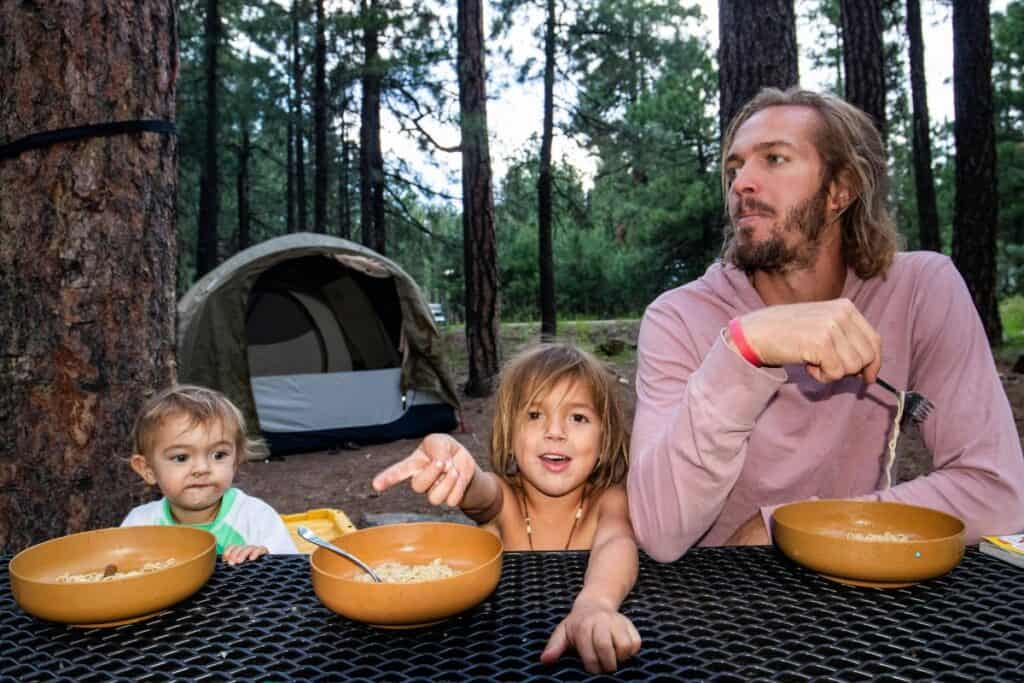
One of the biggest misconceptions about full-time RV living with kids and RV life, in general, is that it’s one never-ending vacation. Just like traditional life though, parents need to work, kids need to learn, and chores/errands need done.
Because of this, maintaining routines and structure while living full-time in an RV is important. Especially with kids, as predictable patterns help children feel grounded and secure, which makes the lifestyle sustainable for everyone involved.
Unlike traditional home life, however, RV living requires adapting routines to different locations, weather conditions, and travel schedules.
Here is an RV kids routine you can use to help develop your own version tailored to your family.
- Morning Routine
- Breakfast and quick kitchen cleanup
- Personal space tidying
- Educational classroom work
- Afternoon Routine
- Lunch
- Quick mid-day tidy-up
- Additional classroom or hands-on learning
- Meal prep and planning
- Free time
- Evening Tasks
- Dinner and clean up
- Next-day planning
- Family time
- Bedtime Routine
- Electronics shutdown
- RV secure check
- Personal hygiene tasks
- Quiet reading time
- Next-day preparation
Travel days require special routines. To help make the process smoother make sure to involve the kids. Each family member should be assigned an age-appropriate task or tasks on moving days.
Remember, structure doesn’t mean inflexibility, the whole point of RV life is to inject spontaneity and adventure into your world.
Teaching children to be flexible while maintaining their core responsibilities is a valuable life skill that comes naturally with this lifestyle. A good way to look at is “flexible structure” – having clear expectations but being ready to adapt when circumstances require it.
Key 6: Foster Social Connections
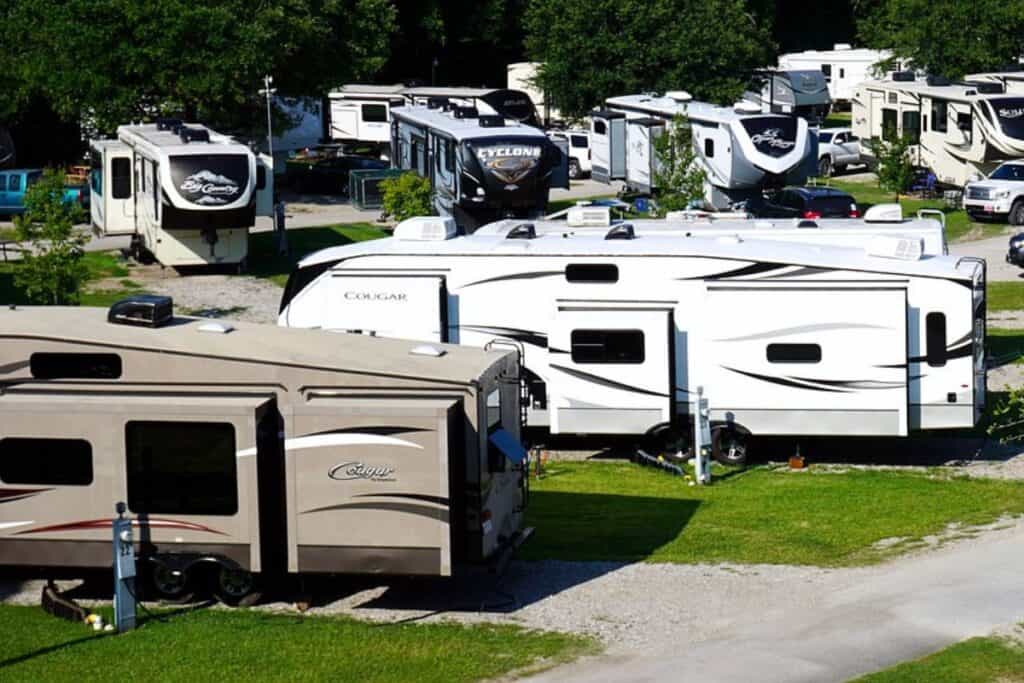
Building a vibrant social life while traveling requires intentionality and creativity for both kids and adults.
Instead of convenient neighborhood friends or classroom buddies, you’ll need to rely on nationwide communities of like-minded families who share your adventurous spirit. The best part though is that your children can form deep friendships with kids from all walks of life, creating connections that span the country and transcend traditional geographic boundaries.
Here are some of the best ways for RV families to build their social networks:
- Join membership groups
- Attend regular RV rallies and meetups
- Participate in camping club activities
- Connect through RV-specific social media
- Organize regional gatherings
Maintaining relationships with friends and family back home requires deliberate effort but can easily be accomplished through technology. Technology has made social connections from the road much easier than it used to be.
It’s also important not to underestimate the value of family bonding in this lifestyle. While external social connections are crucial, full-time RV living with kids naturally strengthens family relationships. Shared experiences, challenges, and adventures create a unique family dynamic that becomes the foundation for all other social connections.
Key 7: Stay on Top of the Important Stuff

When dreaming about full-time RV living with kids, it’s easy to focus on adventure and freedom. However, mastering the practical aspects of this lifestyle is just as important for long-term success.
Important Things to Stay On Top of While Full-Time RV Living with Kids
- Healthcare: One of the most important considerations for families on the road is healthcare. Many full-time RV families opt for national health insurance plans that offer broader coverage across state lines. Establishing relationships with telemedicine providers is essential for managing routine healthcare needs while traveling.
- Financial Planning & Budgeting: Beyond the initial investment in your rig, ongoing expenses like campground fees, fuel costs, and maintenance require careful budgeting. Many RV families also maintain a larger emergency fund.
- Document Management & Virtual Mailboxes: Managing documents and mail is more complicated when you don’t have a permanent address. A professional mail forwarding service like Escapees RV Club is great for providing a stable address for legal documents, vehicle registration, and important correspondence. Having a fireproof strong box and scanning all important documents to the cloud is also important.
- Mobile Internet: Internet connectivity is the backbone of modern full-time RV living with kids. Often a combination of internet connectivity is needed to ensure a constant connection, including cellular data plans, mobile hotspots, and satellite internet like Starlink Roam.
- Emergency Preparedness: When full-time RV living with kids, emergency preparedness is critical, as you’re carrying your home with you everywhere you go. Because of this, having an emergency plan, money, and supplies is one of the most important things to do.
Having clear procedures for everything from prescription refills to banking helps prevent small challenges from becoming major problems.
Additional Resources for Full-Time RV Living with Kids:
Ready to dive deeper into full-time RV living with kids? If so, check out our other blog posts on full-time RV living.
- 12 Things You Must Do to Prepare for Full-Time RV Living
- 24 Things You Should Never Do While Full-Time RV Living
- Best RV Parks for Full-Time Living: By State
Recent Posts
When cruising down the highway in your RV, the last thing you want is a tire blowout! Not only is it dangerous, but RV tire replacement isn't cheap, costing $200 to $300 per tire. The good news,...
Nothing ruins an RV adventure faster than a breakdown with no way to fix it. Because of this, every RVer should have a well-stocked RV tool kit for those unexpected roadside emergencies and campsite...

